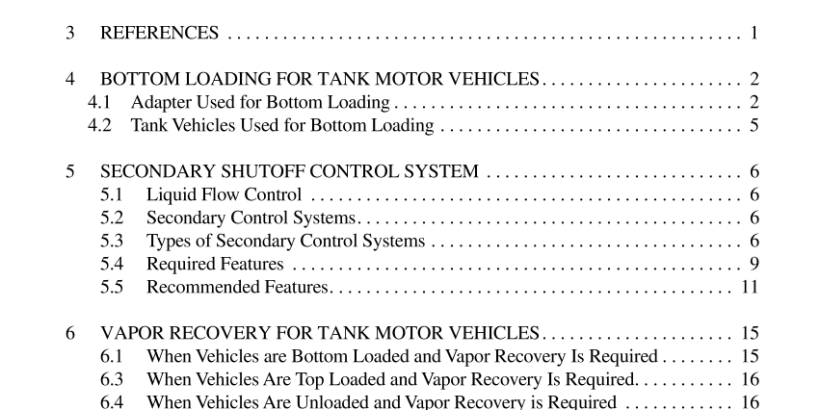API RP 1004:2003 pdf free download.Bottom Loading and Vapor Recovery for MC-306 & DOT-406 Tank Motor Vehicles
4.2.1.4 Piping The tank vehicle’s piping system including components between the loading adapter and any positive shutoff valve, must be designed for a working pressure of 75 psi (517 kilo- pascals) and must not leak at 1.5 times the working pressure. Any component that does not meet this requirement, such as lower rated gravity air eliminators, nonpressure manifolds, or meters, must be isolated from the bottom-loading systems.
4.2.1.5 Venting The vents installed on tank vehicles used for bottom load- ing must have sufficient capacity to prevent damage to the vehicle tank from vapor pressure at the maximum loading rates when the tank is vented at atmospheric pressure. This may require supplementary venting in addition to the breathing vents.
4.2.1.6 Liquid Flow Control The minimum requirements for control of liquid loading are a preset loading-island meter with a set-stop valve for loading a predetermined quantity of liquid and an independent secondary shutoff control system to prevent overfill (see Sec- tion 5).
4.2.1.7 Equipment Safeguard Provisions must be made on the tank vehicle to prevent the vehicle from being moved while any loading or vapor lines are connected.
4.2.2 Recommended Features
4.2.2.1 Deflector When a tank is bottom loaded, the liquid should be effec- tively controlled by a deflector that minimizes spraying, turbu- lence, and generation of static electricity (see API RP 2003).
5 Secondary Shutoff Control System
5.1 LIQUID FLOW CONTROL The minimum requirements for liquid flow control are a primary set-stop or a two stage flow control valve (hereafter referred to as a “primary shutoff control” valve or PSC valve) and an independent secondary shutoff system (here- after referred to as a “secondary shutoff control” or SSC) (see 4.2.1.6). The primary control consists of a preset loading meter and a PSC valve that provides a positive means of selecting and loading a predetermined quantity. The secondary control consists of a level sensor in each compartment being loaded that signals high level to an inde- pendent automatic secondary SSC system that activates the PSC valve and an independent SSC valve to stop flow. The PSC valve and SSC valve at the loading rack must be separate independent devices (See Figure 4A and 4B).
5.2 SECONDARY CONTROL SYSTEMS 5.2.1 Loading-island Mounted A loading-island-mounted system requires an interface connection between the loading-island PSC valve and the tank vehicle. The high-level sensor, through a rack overfill controller, deenergizes the Preset or PSC valve and the inde- pendent SSC valve to stop flow. (Electrical requirements are detailed in 5.4.) Figure 4A and 4B show general schematics for lane shutdown and rack shutdown, respectively. 5.2.2 Tank Mounted Tank-mounted systems require a vehicle emergency valve that can stop flow when triggered by a signal from a high-level sensor. Systems that operate with either air or liquid are avail- able. Tank-mounted systems are most often used on aviation refuelers; however, an electrical interface between the loading island and the vehicle is necessary when loading at a rack.
5.3 TYPES OF SECONDARY CONTROL SYSTEMS
5.3.1 General In systems discussed in 5.3.2 and 5.3.3, the sensor must be deep enough in each of the tank vehicle compartments to assure that once the sensor has been activated, product flow stops before the compartment is completely full. Determina- tion of the proper depth must take into account the maximum product flow rate, shutoff valve response times and tank com- partment volume (that is, the available outage).
5.3.1.1 Maximum product flow rate at the loading rack. For bottom-loading racks, this typically ranges from 600 – 900 gallons per minute (gpm) (2.27 – 3.40 cubic meters per minute (m 3 pm) per loading arm. At 900 gpm (3.400 m 3 pm) the flow is 15 gallons per second (gps) (0.057 cubic meters per second (m 3 ps). This flow rate may be different depending upon product and facility, however, tankers should be pre- pared to load safely at any facility. 5.3.1.2 Shutoff valve response time. Normal flow shutdown time with a properly functioning preset loading meter control (PSC) valve is 1 – 2 seconds. In the rare case when the PSC valve is not functioning properly, the loading flow will be stopped by the independent secondary shutoff (SSC) system and 2 – 4 seconds is typically required. This 2 – 4 second time includes the overfill protection system’s activation time and time for the independent valve (SSC) to close.API RP 1004 pdf download.API RP 1004:2003 pdf free download
